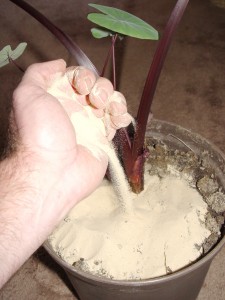Fighting the Fungus Gnats
January 29th, 2013
If you’ve got plants in the house, odds are you’ve seen those tiny black flying insects that most people call “fruit flies.”
They’re actually a common indoor pest called “fungus gnats,” and their favorite living and breeding quarters is the moist soil of potted plants. The larval-stage maggots feed on plant roots, so this bug can do some plant damage in addition to annoying you.
Some people go right to the insecticides, but I’ve found that a combination of sand and patience usually does them in.
Try covering the soil surface of your potted plants with a light layer of sand, which dries out quickly and discourages egg hatch.
Also helpful are not overwatering and not watering too often. Water your houseplants only when the soil surface has dried and the pot has become noticeably lighter. Soggy soil is one of the best ways to kill houseplants.
Another non-chemical control option is trapping fungus gnats on yellow sticky cards glued on sticks around the pot edges. Petroleum jelly works well if you’re making your own cards. So does a product called Tangletrap. These traps also capture other flying insects you might have. And some people say they’ve had good success trapping fungus gnats by setting out a small cup or two of white wine or cider vinegar, which lures the bugs to a drowning demise.
Give these methods some time to work. It’ll usually take at least several days for all of the adults to die and for breeding to end to shut off the flow of new adults.
If you run out of patience or don’t mind applying insecticides, the least toxic product that does a good job at eradicating fungus gnats is BTI (Bacillus thuringiensis var. israelensis). This is a bacterium that’s not harmful to mammals but good at killing the larval stage of fungus gnats. Mix it in water and pour it over the soil.
Gnatrol is one brand that you might run across, but look for the BTI name in the ingredient list to tell if you’re getting the right thing.
Option 3 is using pyrethrin or horticultural oil sprays to control the adults on leaves. You may need two or three treatments 10-14 days apart.
I’d suggest taking your plants outside to spray them, but that’s not always possible in winter. Most houseplants are tropicals that will die or end up damaged after even a short time in freezing weather. Some begin to suffer damage even when temperatures are in the 40s.
I’m not a fan of spraying chemicals of any kind in the house. From a practical point of view, even an oil spray inside could end up staining the drapes. So either take the plants to an unfinished part of the house or hold up some cardboard, plastic or paper behind the plant when spraying.
If you don’t, your spouse might find that your “cure” was far worse than dealing with a family of fungus gnats.








